Cultivation of Cyanobacteria on Sustainable Dried Luffa cylindrica
Abstract
:1. Introduction
2. Materials and Methods
2.1. Pre-Culture
2.2. Cultivation of Cyanobacteria on Various Carrier
2.3. Determination of Released Growth-Promoting Substances by Luffa cylindrica
2.4. Cultivation of N. muscorum 1453-12a in BG11 and BG11 with Soaked L. cylindrica
2.5. Determination of CDW, EPS, Phycobiliproteins, and Pigments
2.6. Analysis of the Cultivation Medium
2.7. Data Processing
3. Results and Discussion
3.1. Screening for Biodegradable Carriers as Cultivation Surface for Phototrophic Biofilms
3.2. Influence of Luffa cylindrica on the Growth of Various Cyanobacteria
3.3. Growth-Promoting Substances Released by Luffa cylindrica
4. Conclusions
Author Contributions
Funding
Institutional Review Board Statement
Informed Consent Statement
Data Availability Statement
Conflicts of Interest
References
- Whitton, B.A. Ecology of Cyanobacteria II: Their Diversity in Space and Time; Springer: Dordrecht, The Netherlands, 2012; ISBN 9789400738553. [Google Scholar]
- Stanier, R.Y.; Cohen-Bazire, G. Phototrophic prokaryotes: The cyanobacteria. Annu. Rev. Microbiol. 1977, 31, 225–274. [Google Scholar] [CrossRef] [PubMed]
- Galetović, A.; Seura, F.; Gallardo, V.; Graves, R.; Cortés, J.; Valdivia, C.; Núñez, J.; Tapia, C.; Neira, I.; Sanzana, S.; et al. Use of Phycobiliproteins from Atacama Cyanobacteria as Food Colorants in a Dairy Beverage Prototype. Foods 2020, 9, 244. [Google Scholar] [CrossRef] [PubMed]
- Vijayakumar, S.; Menakha, M. Pharmaceutical applications of cyanobacteria—A review. J. Acute Med. 2015, 5, 15–23. [Google Scholar] [CrossRef]
- Nozzi, N.E.; Oliver, J.W.K.; Atsumi, S. Cyanobacteria as a Platform for Biofuel Production. Front. Bioeng. Biotechnol. 2013, 1, 7. [Google Scholar] [CrossRef] [PubMed]
- Carpine, R.; Sieber, S. Antibacterial and antiviral metabolites from cyanobacteria: Their application and their impact on human health. Curr. Res. Biotechnol. 2021, 3, 65–81. [Google Scholar] [CrossRef]
- Żymańczyk-Duda, E.; Samson, S.O.; Brzezińska-Rodak, M.; Klimek-Ochab, M. Versatile Applications of Cyanobacteria in Biotechnology. Microorganisms 2022, 10, 2318. [Google Scholar] [CrossRef]
- Pagels, F.; Vasconcelos, V.; Guedes, A.C. Carotenoids from Cyanobacteria: Biotechnological Potential and Optimization Strategies. Biomolecules 2021, 11, 735. [Google Scholar] [CrossRef]
- Khalifa, S.A.M.; Shedid, E.S.; Saied, E.M.; Jassbi, A.R.; Jamebozorgi, F.H.; Rateb, M.E.; Du, M.; Abdel-Daim, M.M.; Kai, G.-Y.; Al-Hammady, M.A.M.; et al. Cyanobacteria-From the Oceans to the Potential Biotechnological and Biomedical Applications. Mar. Drugs 2021, 19, 241. [Google Scholar] [CrossRef]
- Lakatos, M.; Strieth, D. Terrestrial Microalgae: Novel Concepts for Biotechnology and Applications. In Progress in Botany; Cánovas, F.M., Lüttge, U., Matyssek, R., Eds.; Imprint; Springer: Cham, Switzerland, 2018; Volume 79, pp. 269–312. ISBN 978-3-319-71412-7. [Google Scholar]
- Ennaceri, H.; Ishika, T.; Mkpuma, V.O.; Moheimani, N.R. Microalgal biofilms: Towards a sustainable biomass production. Algal Res. 2023, 72, 103124. [Google Scholar] [CrossRef]
- Lau, N.-S.; Matsui, M.; Abdullah, A.A.-A. Cyanobacteria: Photoautotrophic Microbial Factories for the Sustainable Synthesis of Industrial Products. BioMed Res. Int. 2015, 2015, 754934. [Google Scholar] [CrossRef]
- Cao, S.; Wang, J.; Chen, H.; Chen, D. Progress of marine biofouling and antifouling technologies. Chin. Sci. Bull. 2011, 56, 598–612. [Google Scholar] [CrossRef]
- Zhuang, L.-L.; Hu, H.-Y.; Wu, Y.-H.; Wang, T.; Zhang, T.-Y. A novel suspended-solid phase photobioreactor to improve biomass production and separation of microalgae. Bioresour. Technol. 2014, 153, 399–402. [Google Scholar] [CrossRef]
- Kaewprasit, C. Relationships Between a Cotton Fiber’s Specific Surface Area and Its Physical Properties. Text. Res. J. 2004, 74, 730–734. [Google Scholar] [CrossRef]
- Chetsumon, A.; Maeda, I.; Umeda, F.; Yagi, K.; Miura, Y.; Mizoguchi, T. Antibiotic production by the immobilized cyanobacterium, Scytonema sp. TISTR 8208, in a seaweed-type photobioreactor. J. Appl. Phycol. 1994, 6, 539–543. [Google Scholar] [CrossRef]
- Chetsumon, A.; Fujieda, K.; Hirata, K.; Yagi, K.; Miura, Y. Optimization of antibiotic production by the cyanobacteriumScytonema sp. TISTR 8208 immobilized on polyurethane foam. J. Appl. Phycol. 1993, 5, 615–622. [Google Scholar] [CrossRef]
- Walther, J.; Erdmann, N.; Stoffel, M.; Wastian, K.; Schwarz, A.; Strieth, D.; Muffler, K.; Ulber, R. Passively immobilized cyanobacteria Nostoc species BB 92.2 in a moving bed photobioreactor (MBPBR): Design, cultivation and characterization. Biotechnol. Bioeng. 2022, 119, 1467–1482. [Google Scholar] [CrossRef]
- Rippka, R.; Herdman, M.; Waterbury, J.B. Generic Assignments, Strain Histories and Properties of Pure Cultures of Cyanobacteria. Microbiology 1979, 111, 1–61. [Google Scholar] [CrossRef]
- Strieth, D.; Stiefelmaier, J.; Wrabl, B.; Schwing, J.; Schmeckebier, A.; Di Nonno, S.; Muffler, K.; Ulber, R. A new strategy for a combined isolation of EPS and pigments from cyanobacteria. J. Appl. Phycol. 2020, 58, 419. [Google Scholar] [CrossRef]
- Bennett, A.; Bogorad, L. Complementary chromatic adaptation in a filamentous blue-green alga. J. Cell Biol. 1973, 58, 419–435. [Google Scholar] [CrossRef]
- Porra, R.J.; Thompson, W.A.; Kriedemann, P.E. Determination of accurate extinction coefficients and simultaneous equations for assaying chlorophylls a and b extracted with four different solvents: Verification of the concentration of chlorophyll standards by atomic absorption spectroscopy. Biochim. Biophys. Acta BBA Bioenerg. 1989, 975, 384–394. [Google Scholar] [CrossRef]
- Chamovitz, D.; Sandmann, G.; Hirschberg, J. Molecular and biochemical characterization of herbicide-resistant mutants of cyanobacteria reveals that phytoene desaturation is a rate-limiting step in carotenoid biosynthesis. J. Biol. Chem. 1993, 268, 17348–17353. [Google Scholar] [CrossRef] [PubMed]
- Temraleeva, A.D.; Dronova, S.A.; Moskalenko, S.V.; Didovich, S.V. Modern methods for isolation, purification, and cultivation of soil cyanobacteria. Microbiology 2016, 85, 389–399. [Google Scholar] [CrossRef]
- Filippidis, A.; Moustaka-Gouni, M.; Papastergios, G.; Katsiapi, M.; Kantiranis, N. Cyanobacteria removal by Hellenic Natural Zeolite. In Proceedings of the Third International Conference Small Decentralized Water & Wastewater Treatment Plants, Skiathos, Greece, 14–16 April 2010. [Google Scholar]
- In-na, P.; Umar, A.A.; Wallace, A.D.; Flickinger, M.C.; Caldwell, G.S.; Lee, J.G. Loofah-based microalgae and cyanobacteria biocomposites for intensifying carbon dioxide capture. J. CO2 Util. 2020, 42, 101348. [Google Scholar] [CrossRef]
- In-na, P.; Sharp, E.B.; Caldwell, G.S.; Unthank, M.G.; Perry, J.J.; Lee, J.G.M. Engineered living photosynthetic biocomposites for intensified biological carbon capture. Sci. Rep. 2022, 12, 18735. [Google Scholar] [CrossRef] [PubMed]
- Akhtar, N.; Iqbal, J.; Iqbal, M. Removal and recovery of nickel(II) from aqueous solution by loofa sponge-immobilized biomass of Chlorella sorokiniana: Characterization studies. J. Hazard. Mater. 2004, 108, 85–94. [Google Scholar] [CrossRef] [PubMed]
- Iqbal, M.; Edyvean, R.G.J. Loofa sponge immobilized fungal biosorbent: A robust system for cadmium and other dissolved metal removal from aqueous solution. Chemosphere 2005, 61, 510–518. [Google Scholar] [CrossRef]
- Chen, J.-P.; Lin, T.-C. High-density culture of hepatocytes in a packed-bed bioreactor using a fibrous scaffold from plant. Biochem. Eng. J. 2006, 30, 192–198. [Google Scholar] [CrossRef]
- Ogbonna, J.C.; Liu, Y.-C.; Liu, Y.-K.; Tanaka, H. Loofa (Luffa cylindrica) sponge as a carrier for microbial cell immobilization. J. Ferment. Bioeng. 1994, 78, 437–442. [Google Scholar] [CrossRef]
- Pringle, J.H.; Fletcher, M. Influence of substratum wettability on attachment of freshwater bacteria to solid surfaces. Appl. Environ. Microbiol. 1983, 45, 811–817. [Google Scholar] [CrossRef]
- Chen, Y.; Su, N.; Zhang, K.; Zhu, S.; Zhu, Z.; Qin, W.; Yang, Y.; Shi, Y.; Fan, S.; Wang, Z.; et al. Effect of fiber surface treatment on structure, moisture absorption and mechanical properties of luffa sponge fiber bundles. Ind. Crops Prod. 2018, 123, 341–352. [Google Scholar] [CrossRef]
- Strieth, D. Produktive Phototrophe Biofilme in Aerosolreaktoren, 1st ed.; Verlag Dr. Hut: München, Germany, 2019; ISBN 978-3843939515. [Google Scholar]
- Characklis, W.G.; McFeters, G.A.; Marshall, K.C. Physiological Ecology in Biofilm Systems; Wiley and Sons: New York, NY, USA, 1990. [Google Scholar]
- Allaf, M.M.; Peerhossaini, H. Cyanobacteria: Model Microorganisms and Beyond. Microorganisms 2022, 10, 696. [Google Scholar] [CrossRef] [PubMed]
- Ekelhof, A.; Melkonian, M. Microalgal cultivation in porous substrate bioreactor for extracellular polysaccharide production. J. Appl. Phycol. 2017, 29, 1115–1122. [Google Scholar] [CrossRef]
- Schooling, S.R.; Beveridge, T.J. Membrane vesicles: An overlooked component of the matrices of biofilms. J. Bacteriol. 2006, 188, 5945–5957. [Google Scholar] [CrossRef]
- Sluiter, A.; Hames, B.; Hyman, D.; Payne, C.; Ruiz, R.; Scarlata, C.; Sluiter, J.; Templeton, D.; Wolfe, J. Determination of Total Solids in Biomass and Total Dissolved Solids in Liquid Process Samples: Laboratory Analytical Procedure (LAP); Technical Report NREL/TP-510-42621; National Renewable Energy Laboratory: Golden, CO, USA, 2008.
- Alhijazi, M.; Safaei, B.; Zeeshan, Q.; Asmael, M.; Eyvazian, A.; Qin, Z. Recent Developments in Luffa Natural Fiber Composites: Review. Sustainability 2020, 12, 7683. [Google Scholar] [CrossRef]
- Adeyanju, C.A.; Ogunniyi, S.; Ighalo, J.O.; Adeniyi, A.G.; Abdulkareem, S.A. A review on Luffa fibres and their polymer composites. J. Mater. Sci. 2021, 56, 2797–2813. [Google Scholar] [CrossRef]
- Afreen, S.; Bano, F.; Ahmad, N.; Fatma, T. Screening and optimization of laccase from cyanobacteria with its potential in decolorization of anthraquinonic dye Remazol Brilliant Blue R. Biocatal. Agric. Biotechnol. 2017, 10, 403–410. [Google Scholar] [CrossRef]
- Büchs, J.; Zeols, B. Evaluation of Maximum to Specific Power Consumption Ratio in Shaking Bioreactors. J. Chem. Eng. Jpn. JCEJ 2001, 34, 647–653. [Google Scholar] [CrossRef]
- Losen, M.; Frölich, B.; Pohl, M.; Büchs, J. Effect of oxygen limitation and medium composition on Escherichia coli fermentation in shake-flask cultures. Biotechnol. Progress. 2004, 20, 1062–1068. [Google Scholar] [CrossRef]
- Anderlei, T.; Büchs, J. Device for sterile online measurement of the oxygen transfer rate in shaking flasks. Biochem. Eng. J. 2001, 7, 157–162. [Google Scholar] [CrossRef]
- Eriksen, N.T. Production of phycocyanin—A pigment with applications in biology, biotechnology, foods and medicine. Appl. Microbiol. Biotechnol. 2008, 80, 1–14. [Google Scholar] [CrossRef]

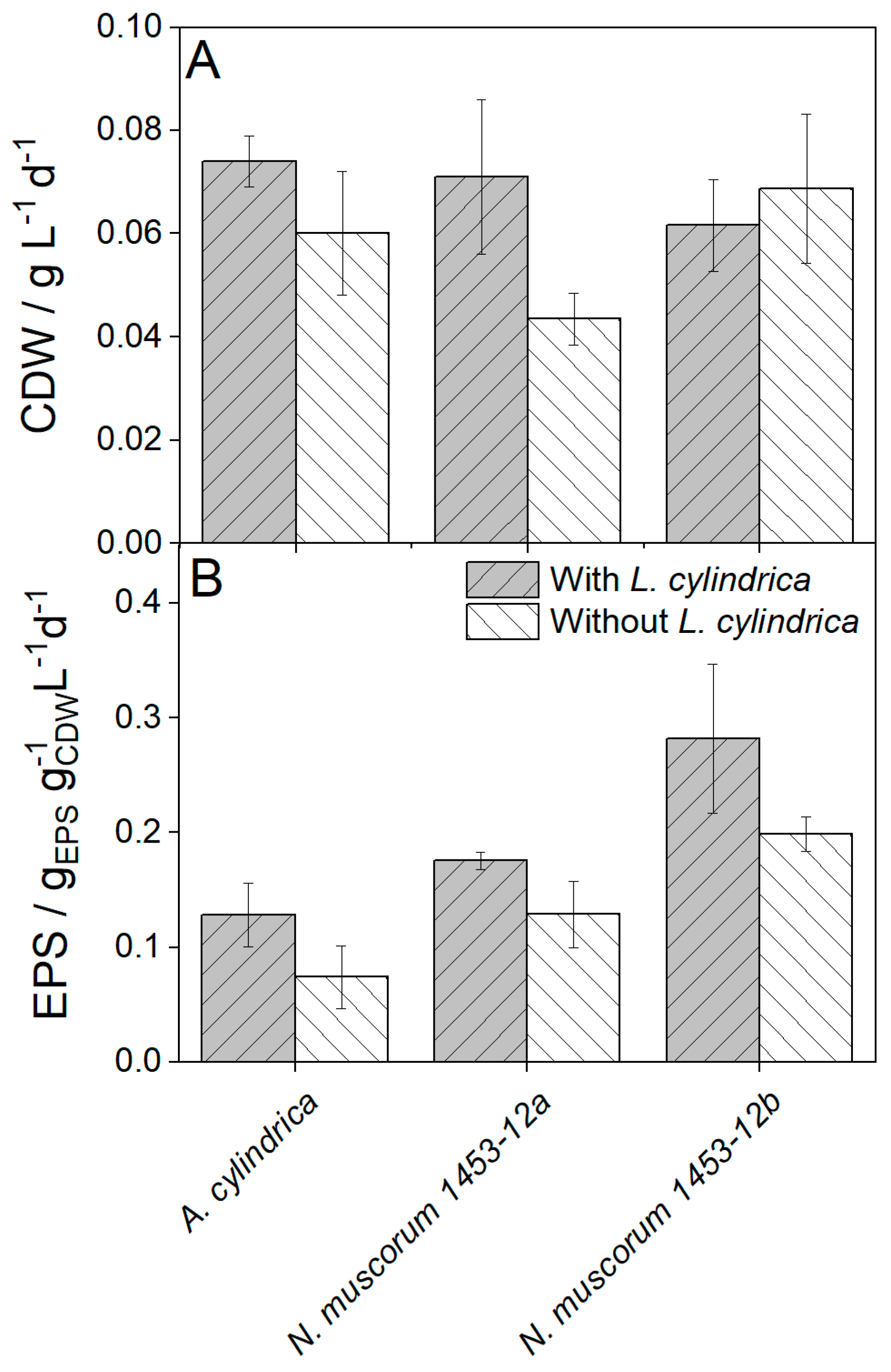
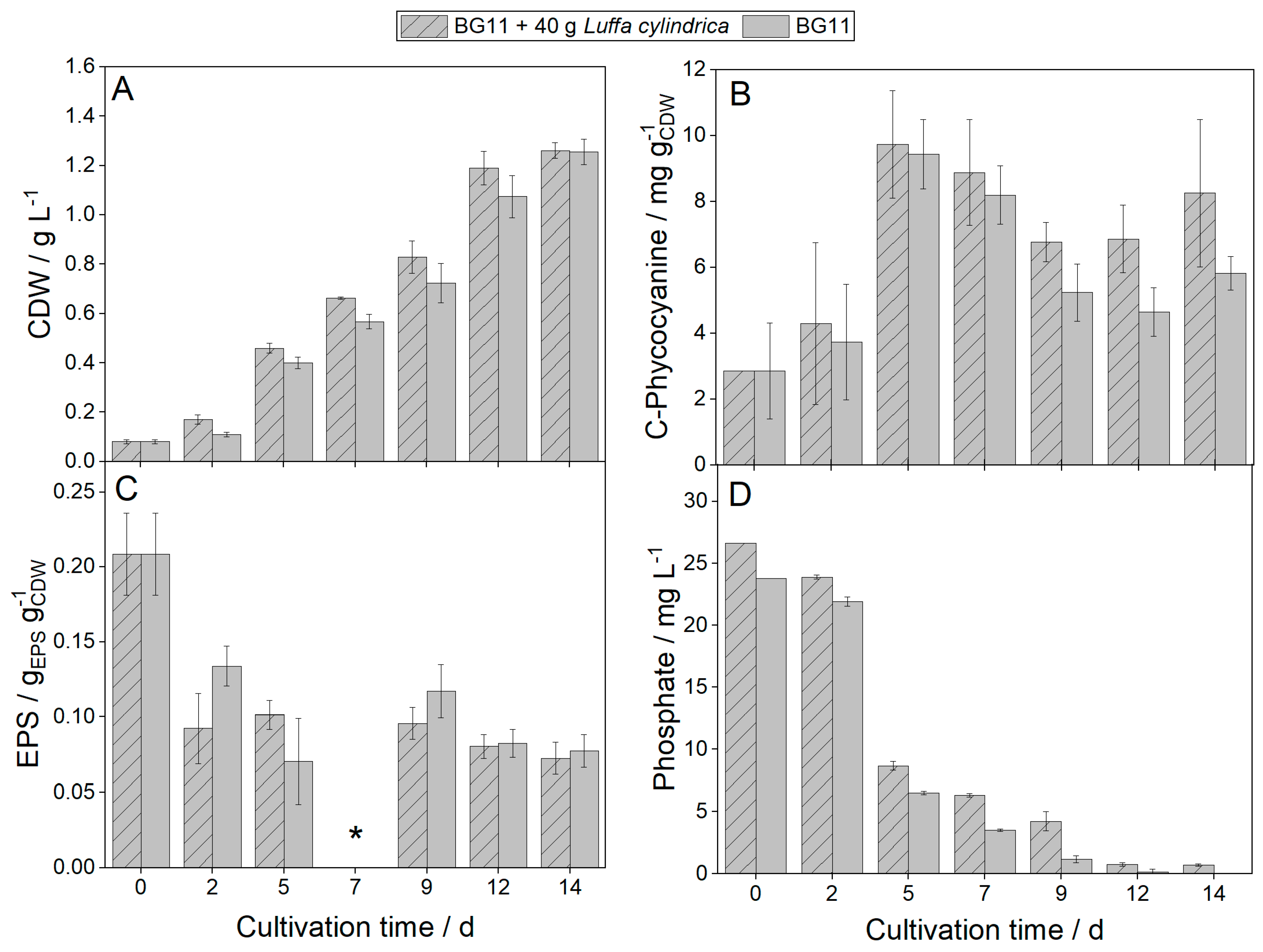
| Carrier | Picture of Erlenmeyer Flask Filled with the Carrier before Cultivation | Picture of Erlenmeyer Flask Filled with the Carrier after Cultivation | Growth | Notes |
|---|---|---|---|---|
| Corn stalk |  | 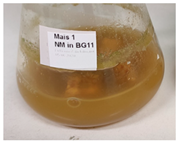 | No | Contaminations observed |
| Luffa cylindrica |  | 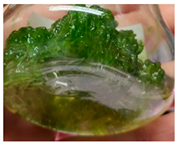 | Yes | Biomass grew on the surface |
| 3D-printed Luffa | 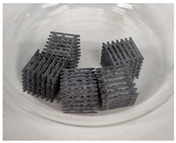 |  | No | Some biomass grew in the supernatant |
| Zeolite | 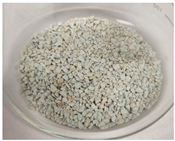 |  | Yes | Biomass grew mainly in the supernatant and at the flask wall |
| Anions/Cations | The Concentration of Ions in Distilled Water Soaked with 20 g L. cylindrica (mg L−1) | The Concentration of Ions in Distilled Water (mg L−1) |
|---|---|---|
| Nitrate | 4.36 ± 3.93 | 1.84 ± 1.60 |
| Nitrite | 0.91 ± 0.29 | 0.65 ± 0.02 |
| Chloride | 4.31 ± 1.23 | 0.61 ± 0.01 |
| Phosphate | 13.22 ± 9.92 | 0 |
| Sulfate | 10.51 ± 3.34 | 3.06 ± 0.02 |
| Sugar | 0 | 0 |
Disclaimer/Publisher’s Note: The statements, opinions and data contained in all publications are solely those of the individual author(s) and contributor(s) and not of MDPI and/or the editor(s). MDPI and/or the editor(s) disclaim responsibility for any injury to people or property resulting from any ideas, methods, instructions or products referred to in the content. |
© 2023 by the authors. Licensee MDPI, Basel, Switzerland. This article is an open access article distributed under the terms and conditions of the Creative Commons Attribution (CC BY) license (https://creativecommons.org/licenses/by/4.0/).
Share and Cite
Kollmen, J.; Stiefelmaier, J.; Mofrad, R.; Strieth, D. Cultivation of Cyanobacteria on Sustainable Dried Luffa cylindrica. Phycology 2023, 3, 472-483. https://doi.org/10.3390/phycology3040032
Kollmen J, Stiefelmaier J, Mofrad R, Strieth D. Cultivation of Cyanobacteria on Sustainable Dried Luffa cylindrica. Phycology. 2023; 3(4):472-483. https://doi.org/10.3390/phycology3040032
Chicago/Turabian StyleKollmen, Jonas, Judith Stiefelmaier, Ramtin Mofrad, and Dorina Strieth. 2023. "Cultivation of Cyanobacteria on Sustainable Dried Luffa cylindrica" Phycology 3, no. 4: 472-483. https://doi.org/10.3390/phycology3040032





